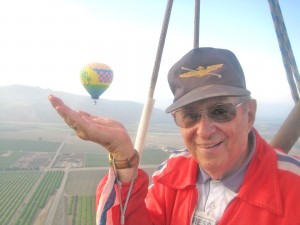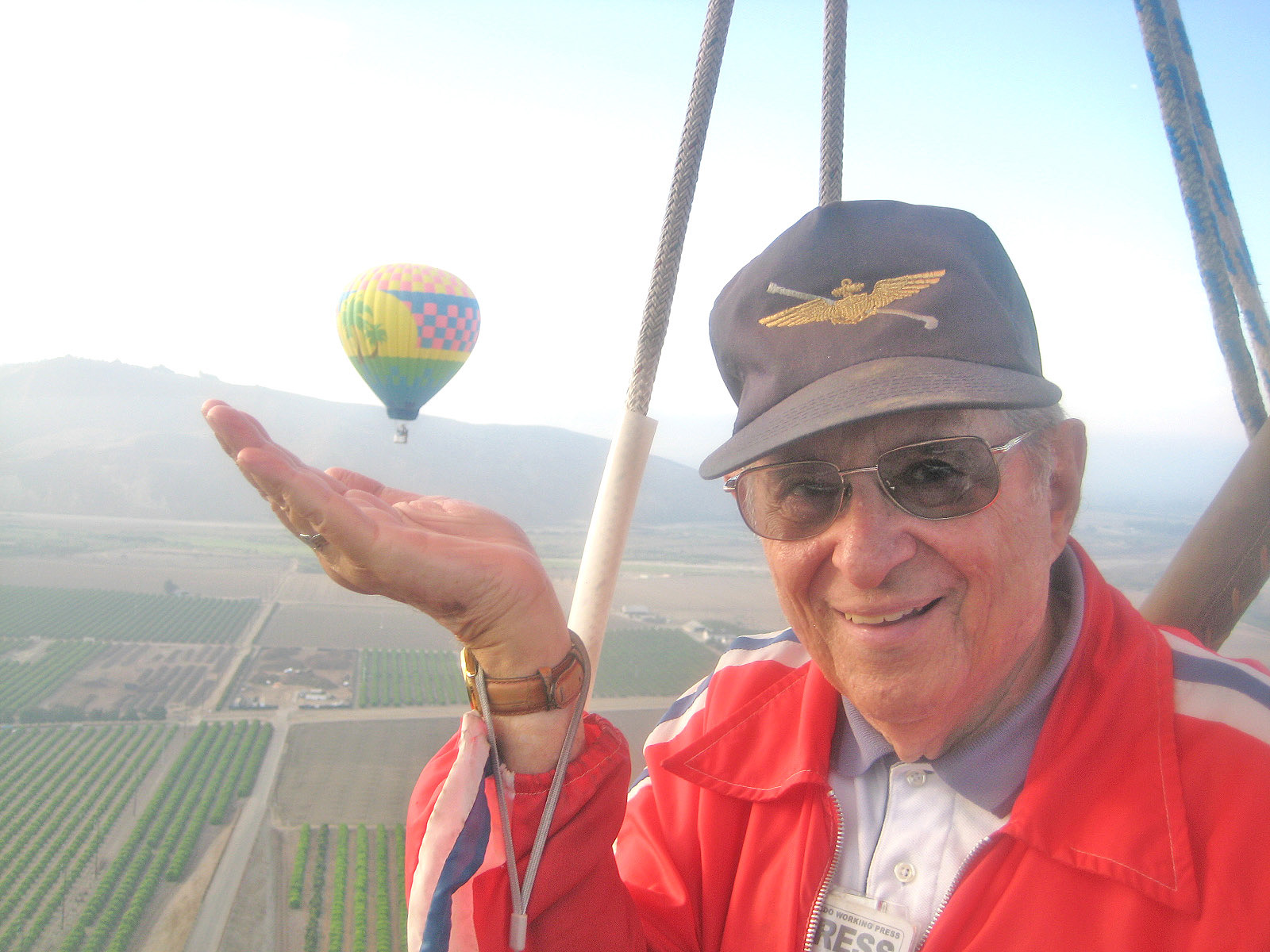
In a hot air balloon above Santa Paula, Calif, Fred Blechman strikes a humorous pose, making it look like the distant companion balloon is about to land on his hand.
By Harlis Brend
Fred “Crash” Blechman bravely launched into his final flight out of earthly existence during the early hours of Nov. 14, 2007. His admission to the West Hills Hospital, in West Hills, Calif., only a few hours before his passing, was the result of the worsening status of an abdominal aortic aneurysm. While he had been aware of this medical condition for many years, Blechman never feared death and never let the condition slow down his life, including participation in his lifelong aviation adventures.
Blechman’s desire was to “quietly pass on” without any formal services or memorial. He left specific instructions detailing the aerial scattering of his ashes for a final landing on South Mountain, overlooking Santa Paula Airport. Dec. 10 was a perfect day for flying and making a beautiful landing. Blechman must have been watching over the pilot’s shoulder, probably taking notes for his first article in the Heavenly Register. When the plane returned to Santa Paula, it made a low pass, scattering thousands of multi-colored rose petals over the runway. A group of friends and family gathered at the field to salute their departed friend and aviator.
Frederick Blechman was born on July 23, 1927, at Far Rockaway, N.Y. The seeds of his desire to become a fighter pilot where planted at the age of 6, when he took his first $5 plane ride in a Staggerwing Beech over New York City. After years of building model airplanes and devouring flying magazines, his dream appeared on the horizon when Blechman joined the U.S. Navy V-5 program as a seaman apprentice in July 1945. The program began with an accelerated college program. He attended classes at Bethany College in West Virginia, Swarthmore College in Pennsylvania, and Columbia University in New York, before becoming an official aviation cadet in August 1946. His training got serious when he entered Selective Flight Training in the N2S-5 Stearman. The training consisted of eight flights; the series had to conclude with a solo flight in order to advance to preflight training. Blechman successfully soloed on Sept. 16, 1946, at Arlington Field near Dallas.

Fred Blechman received his ensign commission and Navy fighter pilot wings of gold on Aug. 23, 1950, at Pensacola.
Blechman didn’t achieve his goal of becoming a fighter pilot at that time. World War II had ended and the military was downsizing. With no guarantees of flying and having received a commission, he took the option to go back into civilian life and continue his college education under the GI Bill. Blechman left the Navy in November 1946; he enrolled in the aeronautical engineering program at Cal-Aero Technical Institute in Glendale, Calif., at the Grand Central Air Terminal.
However, flying was still on Blechman’s mind. He kept in contact with a friend who had chosen to stay in the Navy, soon discovering that the Navy had a new “ab initio” (from the beginning) flight-training program utilizing SNJs as the primary trainer. Blechman became obsessed with getting back into Navy flight training, haunting the Navy recruiter for two years until he finally reentered the service as a naval aviation cadet in November 1948. Now, Blechman was back on track to accomplishing his goal. He completed his basic flight training in SNJs at Pensacola, Fla, which included six arrested carrier landings on the USS Cabot (CVL-28) on March 23, 1950. He later moved on to advanced flight training in the F4U-4 Corsair at Cabaniss Field in Corpus Christi, Texas.
That’s the point in Blechman’s life where his book “Bent Wings—F4U Corsair Action & Accidents” begins, vividly describing his “True Tales of Trial & Terror.” The book leads the reader through the adventures of advanced training and carrier qualifications, and finally to his years as a member of the Navy fighter squadron VF-14 “Tophatters,” flying F4U-5 Corsairs in the Sixth Fleet for two years. His descriptions of flight operations with the old straight-deck carriers paints a true picture of trial and terror as the pilot, approaching the carrier in a descending left turn, the prop barely above stall speed, tries to keep the huge 15-foot nose of the Corsair lined up with the center of the deck landing area.
Blechman received his ensign commission and Navy fighter pilot wings of gold on Aug. 23, 1950, at Pensacola.
“I’ve never done anything more difficult—or of which I’m more proud—than earning those gold wings,” he stated in his book.
After making more than 30 arrested carrier landings, he accomplished another goal—he learned to drive a car.
Blechman’s fighter pilot career definitely had times of trial and terror; he crashed five Corsairs during his Navy career and lived to tell about it. All five planes flew again after repairs, and “Crash” never got a scratch. His last incident occurred on Nov. 7, 1951, while landing on the escort carrier USS Kula Gulf (CVE-108). Landings on the escort carriers were especially difficult in the large, heavy Corsairs; the decks were less than 600 feet long and had only eight arresting cables. Blechman caught the eighth cable. The cable stretched just enough for the prop to catch the extended cable barrier and damaged two prop blades.
During his subsequent medical examination, Blechman discovered he no longer met the flight vision requirements. He had developed astigmatism and lacked proper depth perception. He had a total of 666 hours of flight time, including 455 hours in F4U Corsairs, when he lost his flight status. He served the remainder of his active duty time as an administrative officer on carriers, including the USS Wasp (VC-18), followed by a short time in the Navy Reserve. Lt. Blechman was discharged in November 1952.
After leaving the Navy, Blechman completed his aeronautical engineering education at Cal-Aero Technical Institute, and then worked in the aerospace industry for 15 years. During his career in that industry, he worked on the Atlas missile project at Sunstrand Corp., and was a proposal manager at Bunker Ramo. He also worked at Lockheed in their Missile & Space Division. In 1968, he retired from the aerospace industry and worked full time in his own marketing business, until his retirement about 10 years ago.
Years later, Blechman parlayed his five crashed Corsairs into his now infamous comment about being a “Japanese ace” for having brought down five Corsairs. He shared his amazing experiences through many speaking engagements, relating true tales of trial and terror in the air with a vivid and humorous flare. These speaking engagements motivated him to write two aviation books: “Bent Wings” and “Flying with the Fred Baron.”

Regular lunches at Wendy’s with a good friend led Fred Blechman to found “Wings Over Wendy’s,” a gathering where veterans and seniors could meet to swap books, magazines and stories about flying.
Blechman, who built and flew radio-controlled model airplanes and held amateur radio license K6UGT, was a member of various aviation organizations, including the Experimental Aircraft Association Camarillo Chapter 723, Association of Naval Aviation and B-17 Combat Crewmen & Wingmen. He was also an honorary member of The Ninety-Nines.
Blechman’s great passion for flying, as an aviation enthusiast and from having served as a Navy fighter pilot, were constant sources for the many interesting articles he authored in a variety of magazines and newspapers. He was always fascinated with how things worked, and in his “spare time” throughout the years, he wrote more than 1,100 magazine articles and eight books about electronics, computers and flying.
Blechman began writing for Airport Journals in 2000 and continued to write regularly, covering events and aviation-related meetings and writing a regular column, “True Tales from the Fred Baron.” In it, he sometimes told stories from his past, but also introduced the audience to airports he visited and planes he flew in the company of friends and new acquaintances.
About eight years ago, Blechman and a good friend, Mickey Epstein, began meeting regularly at a local Wendy’s for lunch. They soon invited a few other veterans and seniors to join them to swap books, magazines and stories about flying. As the word spread, the group grew and the restaurant owner, Ron Ross, offered to open the facility earlier to accommodate the group in the morning. The meeting became a weekly ritual for many who have now become close friends. “Wings Over Wendy’s” continues to meets at the Wendy’s at 6430 Platt Avenue, in Canoga Park, Calif., every Monday at 9 a.m., with an average attendance of 70 people. Members attend from as far away as Pasadena and Valencia.
On the Monday following Blechman’s death, 130 people attended an informal memorial at Wendy’s. The meeting opened with the playing of “Taps”; afterwards, many people spoke to honor and celebrate Blechman’s life.
Ross said it gives him pleasure to provide the meeting place as payback for all that veterans have done for the country.
“It will take seven people to do what Blechman did to lead this organization,” said Art Sherman, who now presides over the meeting.
Up until 2007, Blechman had flown in all but one category of aircraft. To celebrate his 80th birthday last July, he completed that category by riding in a hot air balloon. In a photo of the ride, his sense of humor shows through in a pose with the distant companion balloon looking as if it were about to land in his hand.
Blechman married Selma Weitzer in January 1954. They had two children, Sherry and Gregg. Selma died in November 1973 following a four-year battle with cancer. Blechman married Ev Parker in November 1977. She died in February of this year. Daughter Sherry Williams, grandchildren Stefani and Erika Williams, son Gregg Blechman, and brothers Mickey and Sy survive Blechman.
“He was an inspiration to many, always ready and willing to share his fascinating stories and technical knowledge,” said Sherry Williams. ”
All who knew Fred Blechman will miss him.













